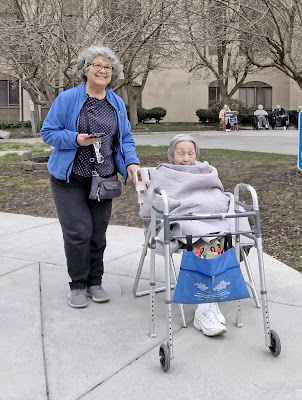Saturday, April 6, 2024 (continued)
Seward House Museum, so-called perhaps, rather than the William H Seward House, because although it happened to be Mr Seward's home address, he did not spend much time there, and thanks to the 1848 New York State Married Women's Property Bill, the house belonged to Seward's wife, Frances, until she died in 1865. Then William Seward did own the house until his death in 1872.
 |
Seward House (1816, for Judge Elijah Miller) originally
had 10 rooms, but an addition was built in 1846-1848;
then another in 1865, creating a 44-room house |
 |
William Seward married Frances Miller, the second
daughter of Elijah Miller, on the condition that Seward
move into this house; Miller lost his first daughter to a
man who moved her away and did not let her see her family |
 |
Wood Brothers Carriage (c 1860) was used by William Seward
to travel back and forth to Washington, DC when he was
Secretary of State to both Abraham Lincoln and Andrew Johnson;
Seward also previously served two terms as a US Senator |
 |
An Alaskan Kayak brought back by Seward after his
1869 trip to the territory he nogotiated to purchase
as Secretary of State for Andrew Johnson |
 |
The stable and carriage house were built in 1860
after an arsonist burned down the barn |
 |
| The stairway in the center hall |
 |
The formal parlor for greeting guests, with three gold-
cushioned French -style gilt chairs from Seward's DC
apartment, in which President Lincoln likely sat... |
 |
Seward traveled extensively, returning
with many souvenirs, including this
wooden bear umbrella stand (c 1867)
from the Black Forest region of Germany |
 |
The library, with a bas relief (c 1859)of Christ, thought
to be a gift from Pope Pius IX, and a large bust (c 1930,
by William Chester French) of William Seward |
 |
Frances and William Seward wrote each other letters when
he was in Albany as a state senator and during his two
non-consecutive terms as governor; this was Frances's "laptop" |
 |
Behind the bust (c 1865, by Thomas D Jones)
of Abraham Lincoln is a series of books about
the Civil War, titled War of the Rebellion |
 |
Copies of a painting (1864, by Francis Bicknell Carpenter)
First Reading of the Emancipation Proclamation of
President Lincoln, and the pages of the preliminary
Emancipation Proclamation read by Lincoln to his Cabinet |
 |
| Drawing room as viewed from the front hall |
 |
| Drawing room as viewed from the rear, and Joe, our tour guide |
 |
Dining room set up as a dinner party Seward
might hold in his DC apartment |
 |
Dining room with a very large German paper mâché
globe that came from William Seward's office in DC |
 |
A silver epergne/table centerpiece
depicting a fox hunt and meant as
a conversation piece |
 |
Diplomatic Gallery: the walls of the entire
second floor central hallway were filled with
portraits of world leaders, most of whom
Seward had met, and a few he simply admired |
 |
A back bedroom was set up like that of Seward's DC
apartment, in which he survived an assassination attempt
the same night that Lincoln was killed at Ford's Theater |
 |
| Bathroom |
 |
The front bedroom was arranged as for Elijah Miller,
the father of Seward's wife, Frances |
 |
Back rooms held an exhibit: Rooted in
Reform, about Auburn Prison that
Judge Miller helped to found, then later
Frances and William fought to reform |
Apparently William Seward volunteeered to defend a Black man who had gone on a rampage and murdered four people in a household. This was after having been wrongfully convicted of stealing a horse and sent to prison where he was repeatedly hit on the head with a length of wood. He became deaf and mentally confused. This trial was the first case in the United States where the insanity defense was raised.
 |
A peek into the small ground floor room
where William Seward spent his last years |
 |
| The sofa bed where Seward died |
 |
Although the Seward family had a kitchen on the main floor,
the earlier kitchen still existed in the basement, and
was used as an Underground Railroad station |
The basement had another exhibit:
Forged in Freedom: The Bond of the Seward-Tubman Families, which recounted the relationship between Harriet Tubman and Frances Seward, as they worked with the Underground Railroad, providing assistance to the freedom seekers in food, clothing, and medications as well as shelter. Once Harriet returned from a trip with an eight-year-old light-skinned Black girl named Margaret, who Tubman said was her niece. (The true relationship has not been verified.) She asked, and Frances was more than willing, to raise Margaret Stewart in her home. During the Civil War, Harriet was the first African American woman to serve in the military, acting as a scout, nurse, and in gathering valuable intelligence. This work made her unavailable to stay with Margaret, but it seems that Margaret was already used to a finer way of life in a free household. She remains a mystery.























































